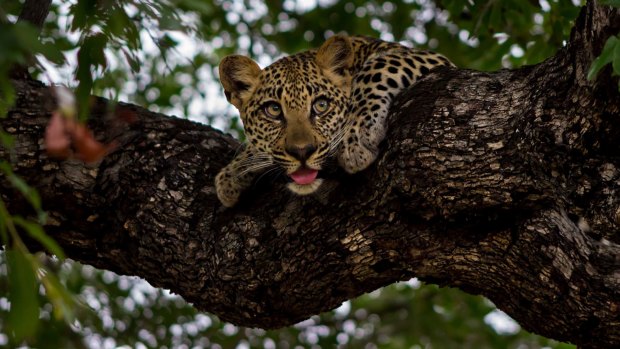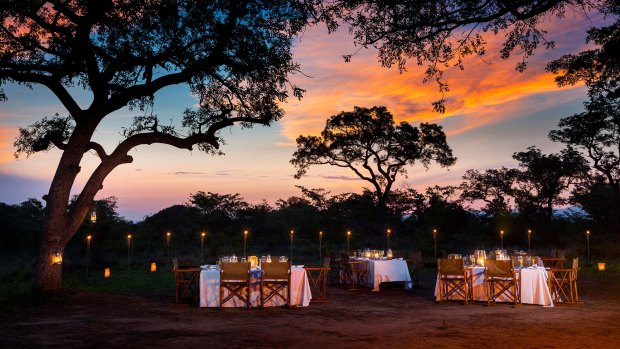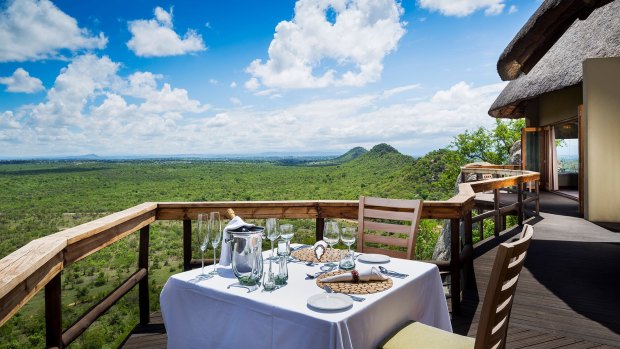This was published 5 years ago
Ulusaba Safari Lodge, South Africa: Richard Branson's lodge a surprising and unlikely thrill
By Ute Junker
On a steamy African afternoon, the idea of a refreshing dip is immensely tempting, and Ulusaba Safari Lodge's two-tiered pool is waiting. There is just one thing to be aware of: the towels on the deckchairs are removed at 4pm. "We find that that's when the baboons come through," a helpful staffer explains. "If we leave the towels out, the baboons cause havoc. So if you do want a swim after 4pm, just ask one of us for a towel."
Towel-snatching baboons are not the only wildlife you are likely to encounter at Ulusaba Safari Lodge. At the 11-room camp, where tree-house style rooms overlook a dry riverbed, animal sightings are a regular occurrence. Each morning as I walk to the restaurant for breakfast, I pass nyala antelope grazing peacefully on the grass and cheeky vervet monkeys gambolling on the boardwalk.
These up-close wildlife experiences make the safari lodge unsuitable for children under 12, but that doesn't mean families miss out. Richard Branson's South African game reserve has another camp, just 10 minutes drive away. Ulusaba Rock Lodge, perched atop a cliff with panoramic views across the plains, is decked out in more contemporary style, with those views adding to the sense of drama.

There is no shortage of big cats in the area surrounding the lodge.
But then, the interiors are only of secondary interest. The biggest selling point at any safari lodge is the quality of its animal action, and this is where Ulusaba scores big. It is one of a number of private game reserves bordering South Africa's biggest national park, Kruger – as there are no fences between the parks, animals can wander freely. That means you get the same spectacular wildlife encounters as you would in Kruger, but without the crowds.
I am travelling with some first-time safari-goers who are amazed by the speed at which they are ticking off the items on their sightings list. Zebra, giraffe, buffalo, even rhino – we see them all during the course of one drive. There are hippos wallowing in shallow pools and plenty of elephants. The first few times an elephant lumbers past within touching distance, my fellow passengers fall into silence, awed by its size, its prehensile trunk and the details of its ridged and wrinkled skin that come into focus when we are this close.
The thing most safari-goers want to see is big cats, and we spot plenty of them. Having spent some time one morning photographing three lions lounging lazily under shady trees, our guide, Phil, suggests we try and track them down on the afternoon drive. It is well after sunset by the time we find them, but the search was worth it. We follow them as they stalk through the long grass in search of prey, comfortable in the knowledge they are the top of the food chain.

Dining under the stars at Ulusaba Safari Lodge.
They aren't our only cat-spottings. On another day, our guide directs our gaze from the ground, where we have been scanning for any movement, up into the trees. He has spied a leopard and her baby lounging on the branches of a tall tree. They are relaxing after a meal, their distended bellies clearly visible. No need to guess what they have been eating: a few branches over hangs a half-devoured impala.
My personal highlight is an encounter with a pack of wild dogs. These endangered animals can be hard to spot; I have been on more than a dozen safaris and never encountered them. Phil promises to try to find me a pack. One evening, as the shadows lengthen, we do find a dozen of them loping along a dry riverbed in search of prey. With their unusually long legs and patchy coats they are a striking sight.
In fact, there is so much game around often we do not know where to look. One morning we stop to watch some dwarf mongoose playing on a tree trunk. At least, we think they are playing; these tiny creatures are so fierce that a playful gambol can be mistaken for a brutal battle. When we eventually look up, we see a hyena strolling across the road just a few metres away. A few more moments and we would have missed it.

The meals are a highlight at Ulusaba Safari Lodge.
It is hard to say what is more thrilling, the morning game drives or the ones in the evening. During the morning drives, you get to watch the world slowly come to life as dawn spreads across the sky. Mornings are a good time to spot colourful birds such as the lilac-breasted roller and the glossy starling. In the afternoon, as shadows lengthen, other forms of wildlife are more active, especially the predators.
There is one other thing that afternoon drives have going for them: when they are over, it is time for dinner. Not that the other meals are shoddy; I particularly enjoy the kudu burger at lunch, made with the meat of a local antelope. However, Ulusaba's three-course dinners are a highlight. A meal might start with an entree of butter bean soup with chilli oil, followed by lamb curry with basmati rice, served with chutney and pappadums. To wrap it all up, there might be a coffee panna cotta. The meal is accompanied by excellent South African wines. When the waiter realises how interested I am in the wines, he offers to arrange a tasting session in the wine cellar.
But my most memorable night-time encounter involves neither wildlife nor wine. Ulusaba has its own observatory, designed to take advantage of the clear skies above the bush. One evening, Phil takes us out to a clearing where a simple hut stands, and rolls out a heavy-duty F10 telescope that he trains on the heavens.
As a warm-up act, Phil shows us the twin stars of Alpha Centauri, which blaze with a furious intensity through the telescope. Then we turn our attention to the main act, one of the most famous constellations in the sky: Orion's belt. In Greek myth, these three stars, neatly lined up, formed the belt of the great hunter Orion. Interestingly, the San people of southern Africa also associated the constellation with a hunt, although their story was very different. In San mythology, each star is actually a zebra. Two nearby constellations also feature in the story: one represents a San hunter, who sent an arrow towards the zebra; the other is a lion that is stalking the same animals.
Our biggest thrill comes when we look through the telescope at Orion. Beyond the three stars lies an immense cloud-like nebula, shimmering with colour. It is a breathtaking sight, and miraculous to think that even though we can't see it, it is shining out there every night.
TRIP NOTES
Ute Junker travelled courtesy of Bench Africa and Virgin Limited Edition.
MORE
FLY
Qantas and South African Airways fly from Sydney and Melbourne to Johannesburg. The connecting flight to Ulusaba takes 80 minutes.
STAY
A three-day package at Ulusaba starts from $2840 a person, including accommodation, meals and beverages, game drives, transfers and Wi-Fi. For more information, contact Bench Africa, benchafrica.com
Sign up for the Traveller Deals newsletter
Get exclusive travel deals delivered straight to your inbox. Sign up now.